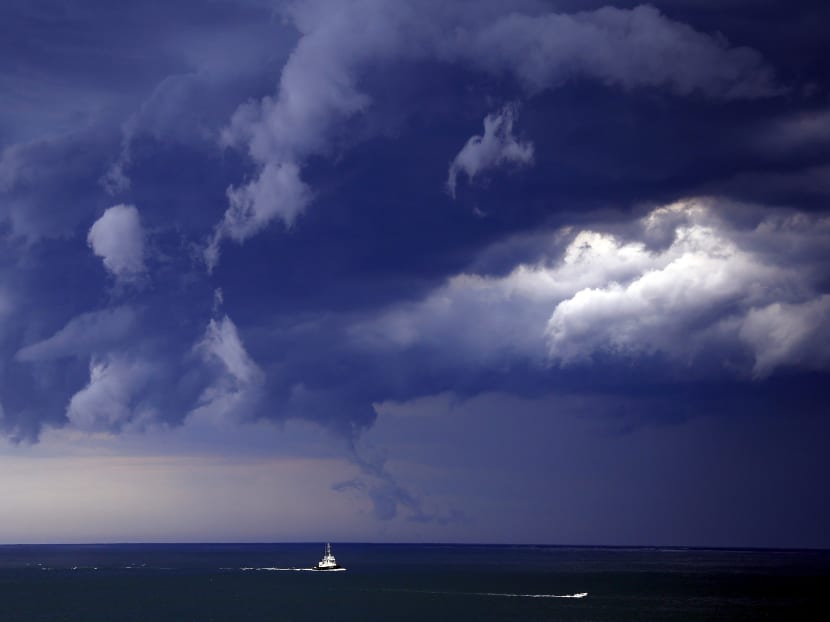‘Thunderstorm Asthma’ kills 8 in Australia
SYDNEY — When Mr David McGann left his office in Melbourne just after 5pm to cycle home, a stifling heat had settled across the city, and the temperature was peaking at 95°C.

Boats head into shore as storm clouds move along the coast towards the city of Sydney, Australia. Reuters file photo
SYDNEY — When Mr David McGann left his office in Melbourne just after 5pm to cycle home, a stifling heat had settled across the city, and the temperature was peaking at 95°C.
A hot, gusty northerly wind picked up. Rain clouds had gathered across the skyline, but there was little relief. “It was the hottest day of the season,” said Mr McGann, 35, who manages accounts at a law practice. “By the time I got home and had a swim, my chest had started to tighten.”
Mr McGann’s partner, Ms Kelli Morris, kissed him goodbye at their apartment to join teammates playing in a nighttime netball competition. When she returned, he was on the couch, sitting quietly, struggling for breath. The inhaler he found after rummaging through drawers was five years past its expiration date.
Mr McGann was one of thousands of people in Melbourne having an attack of thunderstorm asthma. They flooded the city’s emergency rooms, swamped ambulance call lines and joined lines around pharmacies during six hours on Nov 21. All were struggling for breath. About 8,500 people went to hospitals. Eight have died, and one remains in intensive care more than a week after a thunderstorm surged across Melbourne, carrying pollen that strong winds and rain broke into tiny fragments.
Perennial ryegrass seeds were swept up in whorls of wind and carried from four million hectares of pasturelands that lie to Melbourne’s north and west. If broken into fragments, they are so fine that they can be inhaled.
So many people became ill so quickly that some of the state’s crisis medical teams were stretched beyond their limits. Firefighters and police officers stepped in where paramedics were overloaded. Triage centres at 10 hospitals struggled with admissions across Melbourne, Australia’s second-largest city, with a population of 4.4 million in the greater metropolitan area and suburbs.
“This was a health emergency of an unprecedented scale,” said Ms Jill Hennessy, the minister for health and ambulance services in Victoria state, announcing a statewide inquiry. “We have an obligation to ensure that we learn every lesson there is to learn from this event.” Days later, she pledged US$375 million (S$534 million) to add 450 paramedics and build more ambulance stations.
The crisis started just after 6pm and gathered pace so swiftly that paramedics were taking one call for help every four and a half seconds. Ninety minutes later, 175 people across the city were seriously ill, struggling to breathe, and 140 of them were so short of breath that they were considered at risk of dying. Paramedics knew they were in dire straits.
Ms Tracy Shields, 41, a pharmacist working the late shift at Tambassis Pharmacy in Brunswick, a suburb of Melbourne, said she could see a thunderstorm approaching as she headed to work just after 6pm. “The wind started gusting,” she said. “I got out of my car and immediately felt grit in my eyes. And then it started to rain.”
Scientists are uncertain whether the rain caused the grass seeds to swell and rupture, creating minuscule fragments, or whether the wind and heat were enough to break the seeds, creating the conditions that caused thunderstorm asthma.
The previous episode in Melbourne occurred on Nov 25, 2010, but it was not nearly as severe, said Dr Ed Newbigin, an associate professor at the University of Melbourne, where he runs a daily pollen count at the school of biosciences. An earlier episode, in November 1989, sent 277 people to hospitals, and 47 were admitted.
Grass pollen is usually too large to enter the small airways of the lungs, Dr Newbigin said. It can cause hay fever in those who suffer allergic reactions to pollen. Scientists also know winds created in thunderstorms concentrate these tiny seed particles at ground level, where they are easily inhaled.
“Those storm cells pick up all that pollen and dump it in Melbourne,” said Dr Lorraine Baker, who heads the Australian Medical Association in Victoria. “If you are sensitive to ryegrass, which is a very common allergy, it’s like having a whole immune challenge thrown directly into your face. Your airways start to close.”
Emergency services were surprised by the number of so-called silent patients. “They appear OK, but their airways are so obstructed that they are concentrating, really focusing, on staying upright and just breathing,” Dr Baker said.
Mr McGann did not end up in the hospital. But by the time he found a pharmacy open late, he was beginning to panic. “Every breath I took made the next breath harder,” he said, adding that he had no family history of asthma. “I just didn’t realise it could have the effect it had.”
Grass pollen is the primary source of allergies in southern Australia, and tracking the data allowed scientists to forecast high levels of grass seeds in the atmosphere on Nov 21. Still, Ms Hennessy said, the government was taken by surprise.
“When there is a flood or fire, you can see it,” she said. “Unpredictable weather patterns and the impact on health is a new, emerging frontier for public health risks.” THE NEW YORK TIMES






